






Kerry





8

A Few Questions
13


Moving Pictures
‘Dune:









Kerry








‘Dune:

Any vendor of The Contributor can accept VENMO as payment. Technology is a barrier to those experiencing homelessness. Many of our vendors don’t have phones or bank accounts, or use online commerce. Thus we simplified the VENMO process by using one account for all vendors. This means YOU MUST IDENTIFY YOUR VENDOR when using VENMO. Here is the skinny on how to do it right.
#1 You must have a VENMO account. Sign up at www.venmo.com if you haven’t already.
#2 SCAN THE SQUARE QR CODE in the top left corner of the cover of this paper using your phone or tablet camera. Then press the button that appears once it has been recognized.
#3 CLICK the blue “Pay or Request” button on the screen with The Contributor yellow and black logo.
#4 TYPE in the amount you wish to pay The paper costs $2. Tips are welcomed. Vendors get all the money you send and can pick it up the next business day at our o ice.
#5 Most importantly, TYPE YOUR VENDOR’S NAME AND BADGE # in the “What’s this for?” box. Then hit the PAY button. Their name and 4 digit badge #

should be written on the front cover of the paper below the QR code. You must identify them to insure they will get the money. First name, last initial and 4 digit badge # will ensure that a vendor with a similar name doesn’t get confused for your vendor. You can also leave feedback in this field. But always identify the vendor. If they didn’t write their name or badge # on the cover of this paper, please describe where they were and what they looked like. This usually can identify them.
#6
#7 The FIRST TIME you pay anyone using VENMO you will be asked to enter the last 4 digits of their phone number. Type 6829 in this field. Our phone number is (615) 829-6829. Or, you can scroll down and skip this step. (VENMO wants to protect you from sending money to the wrong person with a similar name. The next time you pay a vendor using our account, you won’t be asked to verify again.)
#8 ALWAYS TAKE THE PAPER HOME WITH YOU. When vendors sell out, the satisfaction of having a business that sells out its products begins to sink in! Vendors who sell out, come back to our o ice to buy more. This helps our vendors meet their sales goals. And, it is there that we can meet with them, give them their VENMO payments or mail and work on solving their barriers to housing and life’s goals.
#9 Friend us on VENMO and leave feedback. Open the app and click on “Me” at the bottom. Then select “Transactions” to see your payments. Click on the payment to The Contributor in your transaction list and then click on our icon at the top of the screen to see all of those transactions between us. On this page you can “Friend” us and click on the speech bubble icons of all your payments to leave feedback on your experience. Constructive feedback and praise help encourage our vendors to do their best.


Amanda Haggard & Linda Bailey Co-Editors
Holly Bowman Director of Development
Jesse Call Operations Consultant
Ree Cheers
SOAR Manager
Will Connelly Executive Director
Bri Givens Case Manager
Chelsea Jackson Manager of Vending Operations
Cathy Jennings Director of Finance
Andrew Krinks Editor Emeritus
Caroline Lindner Case Manager
Esther Mwandiko Kitenge Engagement Specialist
Raven Nye
Director of Housing Initiatives
Rachel Ternes
Housing Navigator
Andrew Terry IV
SOAR Referral Specialist
Carli Tharp SNAP Specialist
Justin Wagner Resource Coordinator & Reporter
Tom Wills Senior Advisor/ Data Manager
Barbara Womack Advertising Manager
Will Connelly, Tasha F. Lemley, Steven Samra, and Tom Wills Contributor Co-Founders
Editorials
Requests
Please email advertising requests to: advertising@thecontributor.org




Printed at:




Michael W. ushers in spring with a new apartment after over 15 years selling The Contributor
Even as the weather starts to warm, Contributor vendor Michael W. is staying indoors — he’s still working on pulling the essentials together, but for the first time in half a year, he’s got an apartment of his own.
You might know him by his various nicknames, like Casper or Santa Claus, or the fact that he’s sold The Contributor on and off since a year after the paper’s inception. But despite being a part of Nashville’s community since he moved here in 2003, his recent move-in marks the end of a long fight to get back into housing, and a brutal season surviving on the streets downtown.
“It was a struggle, I was worried. ‘Cause if whatever you hear out here is true, you know, if the mayor or whoever does decide to get all the homeless off the street, where are they gonna put them?”
Michael was housed until late last fall, when a slew of rental issues and
BY JUSTIN WAGNERsecurity concerns drove him out of his apartment. It was one thing after another, whether that meant reckoning with a huge rent increase he only learned about months after it happened or trying to get the locks changed on his apartment door after his room was occupied by strangers.
“The first year was fine,” Michael said. “If the property manager would have helped out a little bit, I’d have probably stayed. But they say, ‘that’s your problem.’ So I left it.”
It was a reminder that in desperate situations, you don’t always have the luxury of trusting the people you meet, he explained.
“I was trying to be Mr. Nice Guy, but you know how that goes. You could be nice to some people and they’ll stab you in the back. They’ll tell you, ‘We’ll help you this, we’ll help you that,’ but they don’t do nothin’. Then if you have
rules … they wanna take over. That’s why I left.”
For those who have experienced homelessness before, leaving behind an apartment can be like starting from square one. Even if you have contacts at all the right places and a good recent rental history, there is usually a long line to get into anything income-based.
“There’s waiting lists on everything,” Michael said. “Even when you go to the doctor, you’re waiting.”
Michael said his new apartment was a fresh start and an opportunity to be free of the troubles at his previous place.
“This is a learning experience,” Michael said. “It’s a whole different ball game.”
It’s also a break from the wear of living outside, which only gets harder in the winter, he said. Getting anywhere for food or water required constant spending on bus passes, and more hiking around downtown streets than he
was consistently able to do.
“In the winter times, I think it’s harder. Other [people say it’s harder in the summer], but you have to bundle up so much. Some will give to you, some won’t,” Michael said. “Now I’ve got a kitchen. It’s not that big, but it’s big enough for me … now I’ve got everything right there, and I can warm things up, and whatever.”
“I like it over there now because I feel more safe.”
Michael’s not done furnishing his new digs and sharing the good news with his customers, but he’s taking things one day at a time. He’s found it “a little boring” to spend so much time indoors, but it’s well worth the peace and quiet.
“It’s gonna take me a few to get used to it,” he said. “I’m gonna give it a try. I don’t mingle too much. I just get off the bus, go to the store, get whatever, and whoosh, I’m at home.”
Developer Adam Rosenberg’s company AGB Real Estate started in Nashville. The company’s first development was built here in 2021 when the business was founded.
“AGB Real Estate’s mission is to develop sustainably focused, affordable, and attainable housing in cities across the Southeast and Mid-Atlantic,” Rosenberg said. “AGB Real Estate stands for ‘Always Getting Better,’ and for me that really spoke to what we at AGB Real Estate endeavor to do. We weren’t necessarily looking to immediately get into affordable housing. We looked at a model to convert motels to apartments and then layered the expertise of one of my business partners on top of it. He has been involved in affordable housing in Washington, D.C., for over a decade.”
AGB’s second development was in Tulsa and their third development is in Nashville as well with several hundred more doors in the pipeline in different locations. Rosenberg sat down with The Contributor to talk about development and housing in Nashville.
Your first project in Nashville was Hermitage Studios where you converted a former Rodeway Inn. You purchased that project at $55,000 per unit. With renovation cost, what was the per-unit cost for this project from start to finish?
That was a very involved redevelopment project. Our biggest challenge in our developments are the additional items that we have to bring into a motel. If you think of a motel room, it typically doesn’t have a kitchen. Bringing in a new kitchen means new electrical and new plumbing. Additionally, Codes requirements changed over the last couple of years. So, we have to put sprinkler systems throughout the buildings and bring them up to apartment-style codes, which is obviously understandable.
A lot of the cost goes towards installing those items — electrical, new plumbing, and fire safety, which, by the way, includes not only a new sprinkler system but also additional hydrants or dedicated fire lines. So, depending on what has to be put into the units, the additional cost can vary from $30,000-$40,000 per unit per project or go as high as $60,000-$70,000 per unit. It all depends on what is already in place.
With that, it’s still significantly below the per unit cost of new construction, correct?
Yes. I think if you do motel conversions like we do, you are looking at a replacement value in the area of over $200,000 per unit. If you build new townhomes, you're in the range of $300,000-$400,000 per unit.
At a public meeting of the Homelessness Planning Council in January, you announced the opening of Wallace Studios, which will come online in 2024 and provide 131 units of permanent supportive housing (PSH). Can you walk us through the financing of a PSH project of this scale?
Our original business model is workforce housing, which is what Hermitage Studios is. These are very attainably priced studios, something a barista, an Uber driver, a warehouse worker or people working at the BNA airport could afford. Our renters are people
BY JUDITH TACKETT
who struggle to find clean, new places to live in the Nashville core. Within about 10 months, we successfully converted a motel into the 108unit Hermitage studios, which is very quick.
At the same time, I reached out to my district councilmember, Erin Evans, to learn more about Mayor Cooper’s $50-million housing initiative. That’s when I learned about affordable housing and the real need Nashville is experiencing. I had no idea until that conversation. And that’s when I reached out to my business partner Ryan (Samuel) who has about 200 Section 8 supportive housing units in Washington, D.C.
The lightbulb moment went off when we [saw] that we could quickly convert these motels and offer a real viable solution to challenges of homelessness here in Nashville. My business partner got equally excited, and we found this property on Wallace Road through brokers. For Wallace Studios, we assembled the same team locally that we used to convert the Hermitage Studios. We closed on that property in August, and we hope to welcome our first tenants in April.
In terms of the financing, we went out to the market to try to get this financed in April 2023. That was around the time that the banking sector was going through significant challenges because of Silicon Valley Bank. Credit lines were really drying up. We talked to over 70 banks. Everyone said no. Even the ones we had worked with before, who knew us, were closed for business. So, we had to think outside the box and one of my business partners has a connection to a bank that he’s done a lot of work with in Washington, D.C. They know him and trust him, and because of that they were nice enough to come down to Tennessee for the first time and provide us with the line of credit for Wallace Studios.
Did you use any government funding like Barnes Trust funds?
No. Not at the moment. The Barnes Fund here in Nashville requires that a nonprofit make the request. Understanding the grants and incentives that are available is something that we’re focused on in 2024. But we move
very, very quickly. Part of the challenge and the pros and cons that we have to consider is that sometimes grants take a long time to get done.
What we’re really focused on, not only for our future tenants but also for our investors, is making sure that we do the best job that we can in the quickest amount of time possible. Looking at Wallace Studios, from when we bought it Aug. 1 to when we opened in April, it will have taken just about eight months to do a 131 unit gut-renovation conversion project.
You are working closely with the Office of Homeless Services. What does that partnership look like?
We have been very impressed with their team. We are extremely interested in understanding the needs and the challenges that Nashville experiences.
They have been nice enough to answer our questions and emails. They have been collaborating with us on creating a detailed lease-up plan, making sure we’re speaking to as many service providers as possible about what we’re going to be bringing to market so that the providers can tell their constituencies about Wallace Studios and then hopefully about many, many more developments.
Is there a specific service provider you work with to ensure the support services are on site?
No. We are looking for a multi-faceted collaborative involvement from multiple support service providers.
Per your Website, “AGB Real Estate is setting new benchmarks for what it means to be a socially responsible, efficient, and be a successful real estate developer.” What does it mean personally to you to be socially responsible, efficient, and still successful in your business?
I look back at the arc of my professional career. I cut my teeth in real estate development doing an apartment to boutique hotel conversion in Panama City, Panama. It was very flashy. I learned a lot. I was involved in every aspect of the development from inte-
rior design to development to branding and marketing to procurement of the furniture, fixtures, and equipment.
What I am doing now is not as “sexy” or flashy. But the ability to have a measurable effect on so many people’s lives is what gets me and my business partners up every morning. As developers and as business professionals you face challenges and headwinds all the time. And for us right now it’s about seizing an opportunity to make a difference in as many lives as possible.
Is there anything else you’d like to highlight?
The city has been fantastic. One of the things I was talking with another developer about is creating need-based incentives for developers like us that really speak to what we’re doing and can help us do more of these developments. I know real estate tax abatements are something that’s been discussed and really has not been well received. But if it’s done on a stepped-up basis, it may work better. For example, if you build units for people at 30 percent AMI (Area Median Income), you get 75 percent tax abatement. If you build for 50 percent AMI, you get 50 percent tax abatement. If you build for zero percent AMI, you get 100 percent tax abatement. That really would make a difference, and I don’t think it would affect the city’s coffers very much. I’m really looking to work with the city leadership to see what is possible. Looking through a new lens in a way that really focuses on creating incentives at that deep, deep affordability level.
The other thing I want to mention, and we already talked to the city about it, is support services for items that developers like me might not think about when we’re doing our projects’ proformas. That could be providing some dollars for security onsite, which is important not only for the development itself but also to reduce the NIMBYism that may pop-up Neighbors have valid concerns about the developments that may be coming to their neighborhoods. We want to be an honest partner and be really an example of what is possible for changing the stigma about what an affordable project development looks like.
My grandmother, Jessie Ely Wills, was a daughter of Ruth Whiteide Ely, of Shelbyville, Tennessee. When my grandfather, Ridley Wills proposed to her in 1898, she agreed to marry him if he would promise to take care of her sister, Mamie, whom Jessie suspected would not marry. He agreed to do so and Mamie lived with Ridley and Jesse at their homes on Patterson Street and Louise Avenue in Nashville until shortly after they moved to their new home, Far Hills, on Curtiswood Lane in 1931. Soon thereafter, Mamie chose to move to Shelbyville where she spent the remainder of her life living in the Dixie Hotel on the public square. The hotel’s proprietor was Dr. C. A. Breast who advertised the Dixie as being “on the Dixie Highway Scenic Route” and the “Florida Short Route.”
His claim was initially true because the U.S. Highway 41, which would go through Murfreesboro and Manchester to Chattanooga, but not Shelbyville, was not completed until the fall of 1925. After U.S. 41 opened, it gradually robbed Shelbyville of most of the north-south traffic. This was the second transportation blow Shelbyville had suffered.
In 1830, Bedford County had the highest population of any county in Tennessee (30,244). This would change. In 1845, the Tennessee General Assembly granted a charter to the Nashville and Chattanooga Railroad Company to connect Nashville with Chattanooga by rail. The next summer and fall, N&C company officers employed John Edgar Thomas, an engineer, to survey the country between the two cities to determine the most inexpensive rail route. Having decided the site of the Franklin County tunnel should be at Cowan, Thomas then laid out a route through the gaps in the Rutherford, Bedford and Coffee County hills, passing through Murfreesboro, Wartrace and Tullahoma but not Shelbyville. Naturally, Shelbyville civic leaders protested, but had to be later satisfied with a branch line from Wartrace.
When the Nashville and Chattanooga Railroad reached Chattanooga in 1854, this meant that Middle Tennessee shippers, such as General Willam G.Harding at Belle Meade, could send their produce, largely corn and other grains, all the way to Savannah on the Atlantic Ocean via the Western and Atlantic Railroad, which reached Chattanooga in 1850, and the Georgia Railroad and Banking Company which ran from Terminus (later renamed Atlanta) to the coast. By not being on the main line, Shelbyville suffered. By 1900, Bedford County had slipped from being the most populous county in the state to the 19th largest.
When the Dixie Highway was built through Shelbyville just before World War II, the economy was given a boost to last until after 1925 when U.S 41 was completed over Monteagle Mountain. This was a shorter route to Chattanooga than the Dixie Highway (U.S.41-A) through Murfreesboro
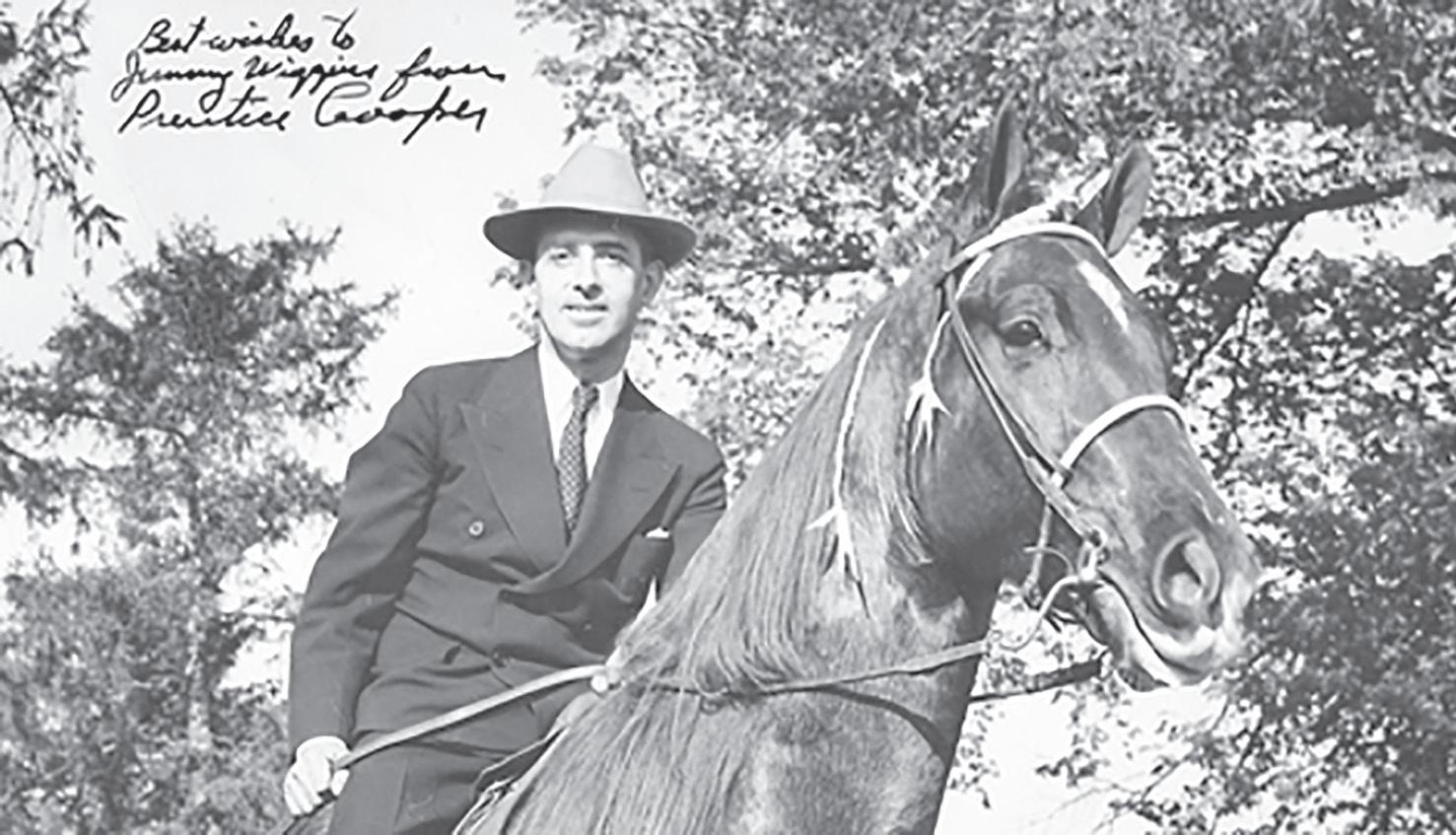
and Shelbyville. Through the Depression, most of the north-south traffic through Shelbyville evaporated and the Dixie Hotel saw a decline in the number of tourists traveling to Florida who stopped there.
In December 1924, a mob of white men in Shelbyville burned down the Bedford County Court House in an effort to capture and hang a Black man accused of rape. The accused man escaped only to be captured and put in the local jail. In order to receive a fair trial, he was moved to Lewisburg, where a jury found him guilty and sentenced him to death, but Shelbyville still had to reckon with their actions ahead of the trial itself. One of his attorneys was Prentice Cooper, who later became the 39th governor of Tennessee.
In 1939, a Walking Horse Celebration was founded in Wartrace. The event drew 40,000 fans in its first year, when trainer Floyd Carouthers and his three-year-old Strolling Jim won the first World Walking Horse Championship. The celebration grew quickly, and, after several years, moved to the much larger Shelbyville where it continued to thrive. In time, Shelbyvllle became known as “The Walking Horse Capital of the World.” For 11 days, beginning in late August, at the celebration, held in an outdoor stadium eventually seating more than 30,000, World Champion winning horses were crowned, initially in three divisions, with the World Grand Champion Tennessee Walking Horse crowned on the Saturday night before Labor Day. Other notable winners have been Merry Go Boy (1947-1948), Garnier’s White Star, the first mare to win the coveted crown (1954), and more recently, I am Josie, in 2013, 2014, and 2015. The Optimist and Rotary Clubs maned booths on the grounds for the eleven days and teenagers at Shelbyville High School could always count on having steady jobs at the celebration grounds where, at its height, the Celebration drew an estimated 2,000 horses, housed in 60 stables, and
250,000 spectators, some of whom came multiple times, and who slept in crowded motels and hotels for miles around. They would bring $51 million in revenue to Shelbyville annually.
During World War II, Shelbyville and Bedford County actually benefited. Because Camp Forrest was in nearby Tullahoma, soldiers from Camp Forrest kept the Dixie Hotel full on weekends when some soldiers even slept on the hotel stairs. In 1943 and 1944, extensive army maneuvers were held across Middle Tennessee. Red army headquarters were often in Shelbyville. Bedford County farmers leased their farms to the military for the maneuvers in which tanks and other military vehicles tore down miles of wire and plank fences, damaged fields, destroyed bridges, utility poles and asphalt roads. After the war, the army made extensive repairs and set up a Claims Board office in Shelbyville to pay farmers for their damages.
Sadly, two blows would hammer Shelbyville. In the 1960s, Interstate 24 was completed from Nashville to Chattanooga. Just as U.S. Highway 41 did, the Interstate bypassed Shelbyville, choosing to go through Murfreesboro, less than a mile of Bedford County, Beechgrove and Manchester before climbing Monteagle Mountain and continuing down Battle Creek Valley in Marion County to Chattanooga. This meant that warehouses would spring up in business parks on I-24 near Manchester rather than in Shelbyville.
In recent years, the famed Tennessee Walking Horse Celebration has drawn controversy and criticism because of the widespread practice of soring horses at the event. This is an abusive practice designed to make horses step higher. This practice was ruled to be illegal in 1970 when a Federal law, the Horse Protection Law, was passed. For years, trainers denied spring and secretly did it anyway. In 2006, concerns escalated
between horse trainers and APHIS inspectors when trainers refused to allow their horses to be tested. The inspectors struck back, disqualifying all but three horses in the Grand World Championship finals that year. Since then, spring has been much better controlled but not entirely eliminated. This took a toll on the Celebration, with unfavorable national publicity and smaller crowds. Every night is followed by a dawn and this has happened in Shelbyville. In 2023, the Walking Horse Justified, owned by Lisa Baum, of Shelbyville, won, for the third consecutive year, the World Grand Championship and the celebration drew an attendance of 130,000.
The city’s population between 2010 and 2020 grew by a healthy 16.4 percent to 23,333, more than one fourth of whom were new to the area — the census identified the largest growth in Hispanic or Somalian who worked in low-paying construction jobs, or at such places as Musgrave Pencil factory and Tyson Foods. The Nearest Green Distillery at 500 Gordon Lane in Shelbyville has been a great success and brings needed tax revenue to the city.
Shelbyville has produced more than its share of local and national leaders, including Gov. Prentice Cooper (1939-1945) and his sons, Jim Cooper, Democratic member of the House of Representatives for the 5th Civil District of Tennessee from 2003 to 2023 and recent Nashville mayor, John Cooper. Then too, there is Nashvillian Jerry Breast, a grandson of C. A. Breast, the 1930s owner of the Dixie Hotel. Jerry is a retired admiral in the U.S. Navy. Their ancestors, buried in Shelbyville’s Willow Grove Cemetery, would be proud of them. My ancestor, Thomas Cooper Whiteside, my great great grandfather, is also buried there. He was a Shelbyvlle bank president and member of the board of the NC&STL Railroad from its inception, as the N&C, to his death in 1885.



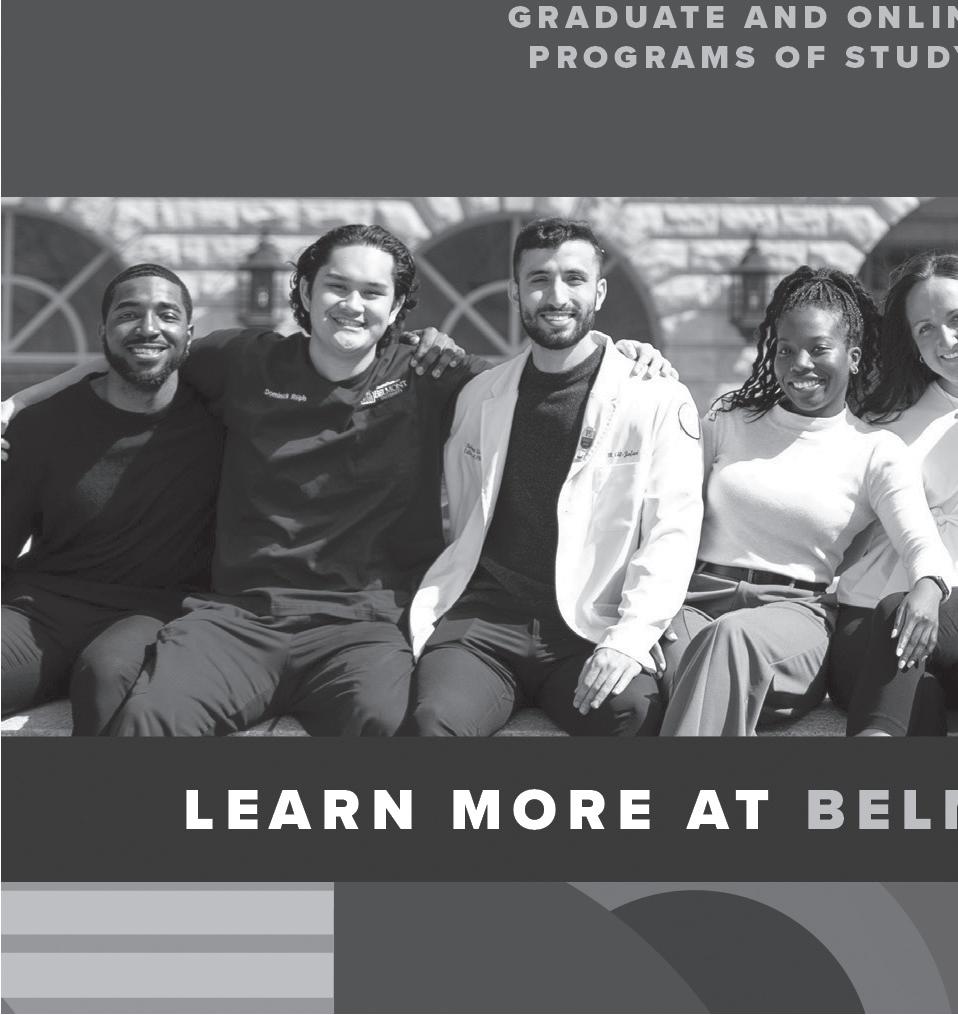



In the early hours of March 7, a tight knit group of supporters including Mayor Freddie O’Connell, former Mayor Megan Barry, Metro Council Member Erin Evans, Judge Robin Kimbrough Hayes and WPLN host Khalil Ekulona honored the hard work and successes of our street newspaper vendors.
The annual breakfast was held at Belmont’s Ayers Center, where we recognized the top street newspaper sellers of 2023 and other contributors who submit literary works, art and other content.
Alex Roach, Maurice Ballard and Norma Bracey emerged as the top newspaper vendors, setting remarkable 2023 sales records. These three newspaper vendors, through rain and sunshine, are extremely dedicated to their businesses and customers. Working alongside Alex, Maurice, and Norma are approximately 180 active newspaper vendors who work hard and become familiar faces in their neighborhoods as they sell The Contributor, share their stories, and create common ground.
The “Rookie of the Year” award went to Terry Holloway, who is constantly working to learn more and has made an impact on his customers’ lives. Terry has also become a mentor to other vendors who want to sell more effectively.
Shawn Lesley was aptly given the “King of Perseverance Award.” Th is self-proclaimed King is also Nashville’s king and queenmaker at his daily sales post close to the Musica statue at Division and 16th Avenue North. Lesley's journey through personal challenges and his successful pursuit of housing stability was recently shared on an episode of Nashville Public Television’s Aging Matters.
In the realm of literary and visual arts, Daniel Holmes was awarded for “Excellence in Creative Expression.” Daniel is dedicated to the arts. His paintings have been featured on the cover of the newspaper, and his writing largely focuses on community involvement in the arts, engaging our readers with the vibrant arts community in Nashville.
Behind every issue of The Contributor is the exceptional work of Franklin Web Printing, who was recognized with the “Editorial Ally Award.” Franklin Webb has been with The Contributor since the printing of the fi rst issue of
the newspaper in 2007. Having a local printer committed to our mission is extremely important to us, and we would not be the newspaper we are without them. Their work is high-quality and consistent, and they care about the vendors and the organization.
Lisa Abell's versatility and creativity earned her the “Excellence in Literary Versatility” award. Her wide range of contributions captures the humor, challenges, and spirit of the vendor community, creating a deep connection with her readers, colleagues, and other supporters. Lisa also shared her story with the audience during the event, adding dignity, encouragement, humor, and hope to all of our stories as we listened awestruck.
As a co-founder of The Contributor back in 2007, the drive behind starting the street newspaper was to “change the panhandling dynamic” where those asking for money and those who can give money often share the same feelings of ambivalence, awkwardness and shame. We dreamed about how offering a newspaper could radically change that interaction. The newspaper would provide a deeper purpose and create an opening for conversation, understanding and mutuality.
Of course, the newspaper would also put money in the hands of people who need it the most. In 2023, street newspaper vendors collectively profited almost $700,000 to pay for things that we all need, like housing, healthcare, food, clothing and other necessities, as well as hobbies, entertainment and other things and expenses that make life easier and sometimes tougher.
Seventy of vendors who sold the newspaper for six consecutive months last year obtained permanent housing, a myth busting stat that challenges the stereotypes of people who are unhoused and their motivations and abilities.
The Contributor is a hyperlocal product trying to make its way through the capitalist marketplace like any other product. However, our street newspaper has a clear aim — to eliminate homelessness and create community. When you buy a street newspaper, you participate in a transaction that is conducive to the betterment of life in Nashville. You can’t always say that about everything you buy.
Nationwide, about half of renters were cost-burdened in 2022, meaning they spent more than 30 percent of their income on rent and utilities, according to America’s Rental Housing Report of 2024, which was published by the Joint Center for Housing Studies of Harvard University.
Tennessee is mentioned three times in that report with regard to increases in outdoor homelessness, which is a consequence of housing affordability and wage increases not keeping up with demand. It is also noted that Tennessee’s response, as a state, was to criminalize homelessness rather than focus on building more affordable housing for cost-burdened, low-income households.
According to the National Low Income Housing Coalition (NLIHC), about 69 percent of Tennesseans whose incomes are at or below 30 percent of the area median income (AMI) are severely cost burdened, meaning they spend more than 50 percent of their income on housing. Based on the NLIHC data, Tennessee lacks close to 130,000 housing units for extremely low-income renters.
The NLIHC report describes extremely low-income renters the following way:
• 35 percent of extremely low-income renter households are in the labor force;
• 22 percent are disabled;
• 26 percent are seniors;
• 4 percent are in school;
• 4 percent are single adult caregivers of a child under 7 years of age; and
• The remaining are listed as “other.”
Since there is some overlap among the categories, the report also clarified that they found that 13 percent of extremely low-income renter households include a single adult caregiver, 49 percent of those usually work at least 20 hours per week. Also, 10 percent of extremely low-income renter households are enrolled in school and of those, 47 percent usually work at least 20 hours per week.
It is not just in Nashville that we experience a housing crisis. In addition, study after study shows that the main reasons for increases in homelessness clearly relate back to the lack of obtainable, affordable housing for people with extremely low incomes. In other words, when poor people pay more than 30 percent of their household income on housing costs (rent/mortgage and utilities), they are more likely to scrimp on other necessities like healthy food and/or healthcare. And they experience unstable housing situations including evictions.
Homelessness in the United States is the result of system failures such as the lack of affordable housing, low wages that do not keep up with the cost of living, and individual difficulties play a lesser role. When I talk to people who are living on the streets, I often hear them blame themselves for their situation. They know that individual circumstances can lead to homelessness. But the fact remains, in communities where affordable housing is available for low-income
BY JUDITH TACKETTpeople, a bad personal decision usually does not lead to homelessness quickly.
In northern European countries, where systems and safety nets are in place, homelessness is more rare and reasons are often based on individual circumstances. In Finland, for example, the country decided to invest in affordable housing and support services. As a consequence, the country has nearly eliminated homelessness.
So, what can we do right here in the United States and in cities like Nashville?
For one, we can elect politicians who understand that housing subsidies and eviction prevention measures are ways to prevent homelessness, stabilize families, increase education outcomes (kids need a place to feel safe where they have the ability to learn and grow), and reform the healthcare system.
Locally, we need to focus on creating housing at all income levels but especially for low-income households. Nashville is taking steps and chipping away on building more affordable housing. But we also have to admit that politics keeps getting in the way of bold vision and leadership – at the state and local levels. We can watch this unfold right now with the current effort around discussions to potentially overhaul Metro’s zoning code. Unfortunately, the NIMBY (Not In My Back Yard) uproar started inside the Metro Council Chambers in February and continues in community meetings. People are shouting at each other rather than listening, and I wonder if that environment lends itself to discuss necessary adjustments to accommodate Nashvillians’ housing needs. And I am talking about all Nashvillians here.
Frankly, I am not even certain where the discussion and urgency of politicians is when it comes to keeping people in their housing. Let’s take a look at eviction filings, as an example. During the height of the COVID pandemic much of the temporary federal funds helped keep people in housing and caused eviction rates to fall. But since then, the money dried up, local politicians have not truly discussed any measures that could help keep eviction rates low, and as a result, Davidson County has seen a 111-percent increase in eviction filings since 2020.
And when we examine who is at the highest risk of eviction in this country, it is our children. According to the National Eviction Lab at Princeton University, children and youth (19 and under) are at the highest risk of eviction in the United States. Having experienced housing instability and homelessness as a child is also one of the risk factors for adult homelessness.
Nashville has been discussing how to counteract the affordable housing crisis for some time. Most recently, a 2021 report from a Mayor’s Taskforce on Affordable Housing lists the following measures: Invest in the Barnes Housing Trust Fund at a rate of $30 million per year; invest in Metro capacity and capability; develop dedicated revenue for affordable housing; create a catalyst fund; leverage underutilized publicly
owned lands; build state support for local community solutions; expand and improve PILOT (payment in lieu of taxes) programs; address zoning issues to reduce barriers to develop strategic and appropriate density; and invest in MDHA’s Envision and improve the impact of housing vouchers.
Since this report, Metro has created a Housing Division within the Department of Planning and has chipped away at these goals. As part of creating accountability, the Housing Division has published dashboards to keep up with Metro’s housing efforts (see: https://dashboards.nashville. gov/t/Metro/views/AH-Dashboard/FinalDashboard_1?%3Aembed=y&%3AisGues-
According to these dashboards, the 2021 Affordable Housing Taskforce Report estimated the housing need for Davidson County by 2030 as follows:
• 35,715 rental units and 1,799 owner-units for households with incomes between 0-30 percent AMI;
• 5,387 rental units and 3,445 owner-units for households with incomes between 31-60 percent AMI; and
• 3,670 rental units and 2,482 owner-units for households with incomes between 61-80 percent AMI.
Another dashboard shows that 12,070 affordable housing units have been funded for preservation or creation with locally financing tools and COVID recovery dollars since 2016. However, in the following chart, we focused only on data reaching back to 2021 in order to align the comparison with the goals of the Affordable Housing Taskforce Report estimates for Davidson County.
In essence, we have funded 5,887 new housing units since 2021 in Davidson County. I am unclear how many affordable housing units were lost during that time frame. I am also unclear how many of those units are actually in place yet. For example, the dashboard shows that Metro funded 90 Permanent Supportive Housing units in 2017, but those units are not expected to be occupied until this spring — once Metro is able to hire a contractor to manage and provide support services.
So far, Metro’s Housing Division has shown leadership and developers have been encouraged by Metro’s willingness to examine innovative solutions that have worked in peer cities. One such example that I came across in Charlotte, N.C., and that I have since learned our city is looking into, is the Housing Impact Fund. This is an investment fund that is focused on buying and preserving unsubsidized affordable housing and has shown promise. The model focuses on purchasing low-income housing complexes and rather than raising rents, the new owners commit to keeping prices affordable for 20 years. A first round of investments in 2020 raised $58 million of social impact capital and resulted in the preservation of 805 apartment units serving over 2,000 residents. The Housing Impact Fund is committed that a third of its units serve households
with incomes at 0-30 percent AMI, half of the units serve households at 31-60 percent AMI, and the rest will serve households between 61-80 percent of AMI. To do this, the City of Charlotte and Mecklenburg County created a partnership to convert property taxes into rental subsidy payments to serve households below 30 percent AMI.
The Housing Division is also taking a deep dive and is in the process of working on an inventory of Metro buildings and properties that in theory could be used for affordable housing construction. I understand that the report is expected to be published in fall of this year.
In addition, the Urban Institute has created an inventory report of potential affordable housing partnerships in Nashville that could theoretically create up to 5,539 new housing units under current land availability and zoning laws, the majority of which (about 95 percent) would come from land owned by the faith-based institutions. The inventory, which was published in November 2023, examined available land owned by faith-based, academic, and health care institutions. It also calculated that up to 14,151 new housing units could be built if subdivisions were created on available land that is currently zoned for single-family residential uses. In addition, if Metro rezoned parcels that are currently zoned as commercial and retail districts, another 9,750 multi-family units could be created.
Looking at all of the information we have on the lack of affordable housing, especially for low-income households, may be discouraging. But we also know what to do. In my observation, the biggest obstacle is that too many people holding leadership positions in Nashville have been catering to politicians. They hold back information for no apparent reason, use the term “Nashville Nice” as an excuse to drag their feet and protect the status quo, and create distrust because their actions do not align with their words. This is the time to change that culture and figure out how to create cross-sector leadership that knows how to work through conflict, overcome NIMBYism, and focus on solutions — even if we have to compromise. We need people in leadership positions who understand accountability and transparency. That’s how we re-engage with each other and build trust. That’s how we invest in the tools to improve quality of life for all neighbors.
Right now we also have a lot of transparent leaders working on addressing affordability and growth. Just read the last few Q&As in The Contributor with community leaders including the mayor, vice mayor, councilmembers, nonprofit advocates, and most recently a private developer who takes a huge risk to invest in and build permanent supportive housing right here in Nashville. When you read these interviews, you will recognize that they are pulling in one direction, which is to build a Nashville for all of us.





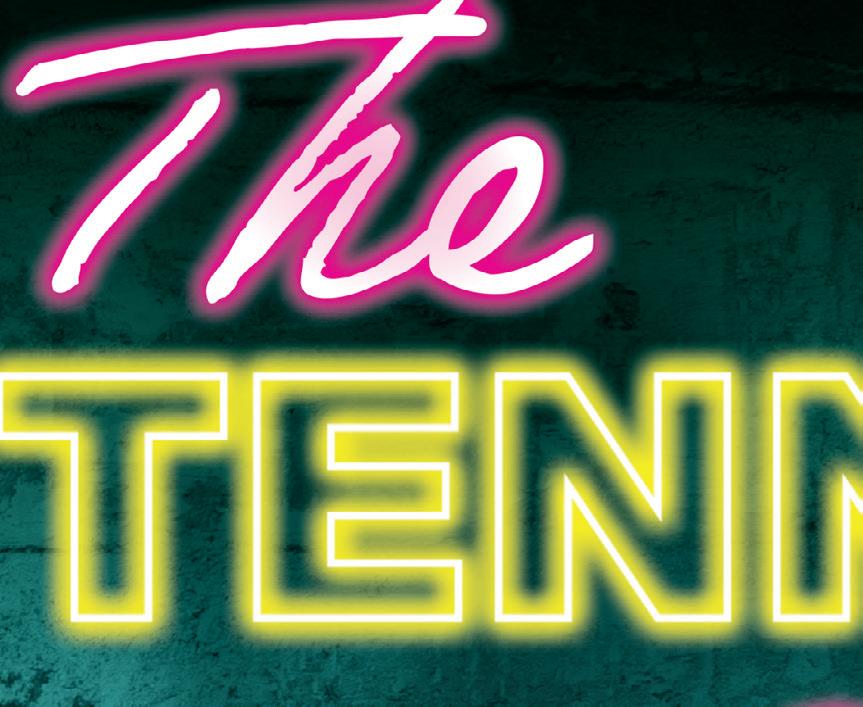



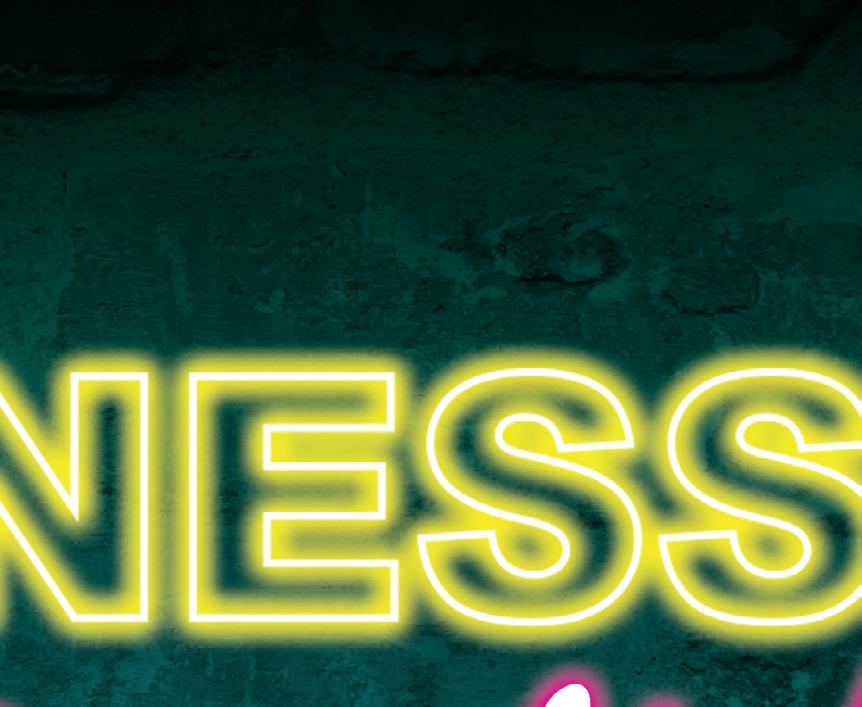




















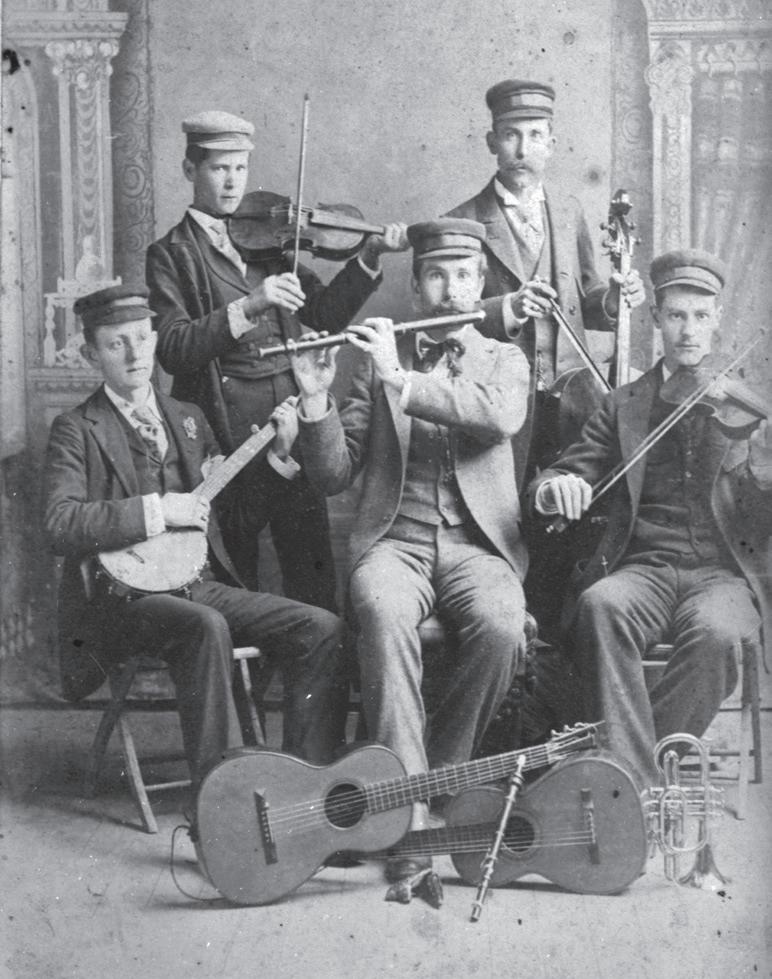















Imagine: the year is 2029. You have been living at the same address for a decade. The postman, who knows you well, smiles as he walks to your door and hands you a bunch of letters. As you sift through them, one card grabs your attention. It says: “Let us know if you are still here.”
It’s an election year and the card from the electoral office is asking you to confirm that you are still a resident at the same address. It has a deadline, and you may be purged from the voter list if you don’t respond to it.
You had read about the government using AI to detect and eliminate electoral fraud through selective querying. Is it the AI pointing fingers at you? A quick check reveals that your neighbors haven’t received any such cards. You feel singled out and insecure. Why have you been asked to prove that you live where you’ve lived for so long?
Let’s look under the hood. You received the card because election officials had deployed an AI system that can triangulate evidence to estimate why some voters should be contacted to check whether they are still a resident at their address. It profiles voters based on whether they display the behavior of a “typical” resident.
In this case, you had taken early retirement and not filed tax returns in the past few years, and you had been on holiday during the previous election in 2024. These actions led the AI to conclude that you could be lingering in the electoral list illegitimately and triggered the system to contact you.
This fictional story is more plausible than you might think. In 2017 and 2018, more than 340,000 Wisconsin residents received a letter asking them to confirm if they needed to remain on the voter list.
This was at the behest of a US-wide organization called Eric, which had classified these voters as “movers” – those who may have ceased to be residents. Eric used data on voting history to identify movers – but also administrative data such as driving license and post office records.Eric may not have used any sophisticated AI, but the logic it employed is very much the kind of logic that an AI would be expected to apply, only on a much larger scale.

The approach seemed highly effective. Only 2 percent of people responded, suggesting that the vast majority of the people contacted were indeed movers. But research later showed systematic demographic patterns among Eric errors. The people erroneously identified as movers (who ended up showing up to vote) were far more likely to be from ethnic minorities.
gerrymandering”
AI algorithms are used in a variety of real-world settings to make judgments on human users. Supermarkets routinely use algorithms to judge whether you are a beer person or a wine person to send you targeted offers.
Every online payment transaction is being assessed by an AI in real-time to decide whether it could be fraudulent. If you’ve ever tried to buy something and ended up triggering an additional security measure – be it a password prompt or request for authentication on a mobile app – your bank’s AI was judging your attempted transaction as abnormal or suspect.
Our research shows that abundant AI capacity is available to make judgments on
whether people’s behavior is deviant or abnormal. To return to our opening example, in a world where early retirement is not the norm, an early retiree has the scales tipped against them.
Such social sorting, carried out by AIbased judgments, could be interpreted as a latent or soft form of majoritarian gerrymandering.
Traditional gerrymandering is the unethical practice of redrawing electoral district boundaries to skew electoral outcomes. AIbased social sorting could disenfranchise people for behaving in a way that deviates from the majority.
The patterns in the Wisconsin case should have us concerned that voters from ethnic minority backgrounds were systematically being classified as deviating from cultural norms.
Who gets a vote?
In an ideal world, the electoral roll would include all eligible voters and exclude all ineligible voters. Clean voter lists are vital for democracy.
Having ineligible voters lurking on lists
opens the possibility for spurious voting, skewing the result and damaging electoral integrity. On the other hand, leaving eligible voters off a list disenfranchises them and could result in election results that don’t reflect the true will of the people.
Ensuring access to the franchise to every eligible voter is therefore very important, and efforts towards clean voter lists need to spread their focus reasonably between integrity and access.
The question, therefore, becomes whether AI is capable of doing this. As it stands today, AI is fundamentally a data-driven technology — one that is adept at looking at existing data and identifying regularities or irregularities.
It is much better equipped to spot issues with existing data than to identify instances of missing data. That means that it is good at identifying people who may have moved from their registered address, but not good at identifying new residents who have not registered to vote.
In a world of AI-driven electoral cleansing, you are much more likely to receive a “are you still here?” card than your new neighbor is likely to receive a “have you considered registering to vote?” card.
What this means for using AI to clean up voter lists is stark. It risks skewing the balance towards checking for integrity and away from enabling access.
Integrity-focused efforts in essence involve pointing fingers at people and putting the onus on them to confirm that they are legitimate voters. Access-focused efforts are like a welcoming pat on the back – an invitation to be part of the political process.
Even if widespread disenfranchisement doesn’t happen, states still risk undermining trust in elections by using AI on a larger scale. It could lead voters to feel that electoral offices are obsessively oriented towards fault-finding and much less interested in democratic inclusion. And at a time when trust in elections is needed more than ever, that perception could be just as damaging as actually cutting people from electoral rolls.
Courtesy of The Conversation / INSP.ngo


This story was originally published by Chalkbeat. Sign up for their newsletters at ckbe.at/newsletters.
Gov. Bill Lee’s proposal to create a statewide school voucher program easily cleared its first Senate hurdle on March 6, but took a split vote and fiveplus hours of often contentious debate to pass out of a House committee.
The legislation — the most ambitious and controversial education plan of Lee’s five-plus years in office — passed 7-1 out of the Senate Education Committee, with the panel’s lone Democrat casting the dissenting vote.
In the House Education Administration Committee, the measure advanced 12-7, including four Republicans voting against it in the GOP-controlled legislature. Passage came even as Maryville City Schools Director Mike Winstead, a 2018 finalist for National Superintendent
of the Year, called vouchers “a bitter pill, maybe some would say a poison pill” that he believes will destabilize K-12 education across Tennessee in the long run.
“You can coat that with a lot of good things and make it go down a little easier,” Winstead testified before the panel. “But in the end, we’re being asked to ingest a poison pill.”
Meanwhile, supporters pounded on the theme of parental choice.
“This is about parents finding the best learning environment for their students,” said Education Commissioner Lizzette Reynolds.
Lee’s Education Freedom Scholarship Act must clear more committees in each chamber before it can be voted on by the full House and Senate. The House bill now heads to that chamber’s government operations committee, while the Senate bill will be heard next by its finance panel.
Both proposals would start a new voucher program this fall with up to 20,000 students who could use taxpayer funding to attend private schools. Lee wants the program opened up eventually for any K-12 student, regardless of their family income.
The pieces of legislation remain vastly different, however, both in cost and scope.
The Senate bill, starting this year at $95 million and jumping to $333 million in the program’s second year, requires voucher recipients to take some type of tests that can be used to compare and rank students, but not the same rigorous standards-based tests that public school students have to take under the Tennessee Comprehensive Assessment Program, known as TCAP. The legislation also would allow public school students to enroll in any district, even if they’re not
zoned for it, provided there’s enough space and teaching staff.
The House version, starting at $398 million and growing to $425 million in the program’s second year, has no testing requirement for voucher recipients. It includes a long list of enticements aimed at public school supporters, including reducing testing time for students, increasing the state’s contribution toward health insurance costs for teachers, requiring fewer evaluations for high-performing teachers, and giving districts an extra $75 per student — or about $73 million in all in the first year — to help with building costs.
Rep. Chris Hurt, a Halls Republican who voted against the bill, expressed concern that the public school measures could get “stripped out” of the final legislation if Senate and House negotiators head to a conference committee to work out their differences.


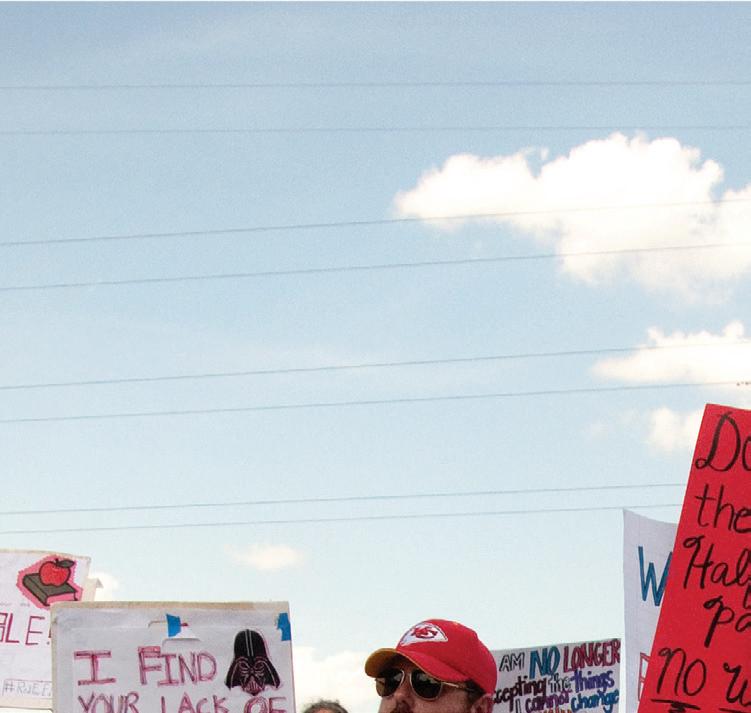
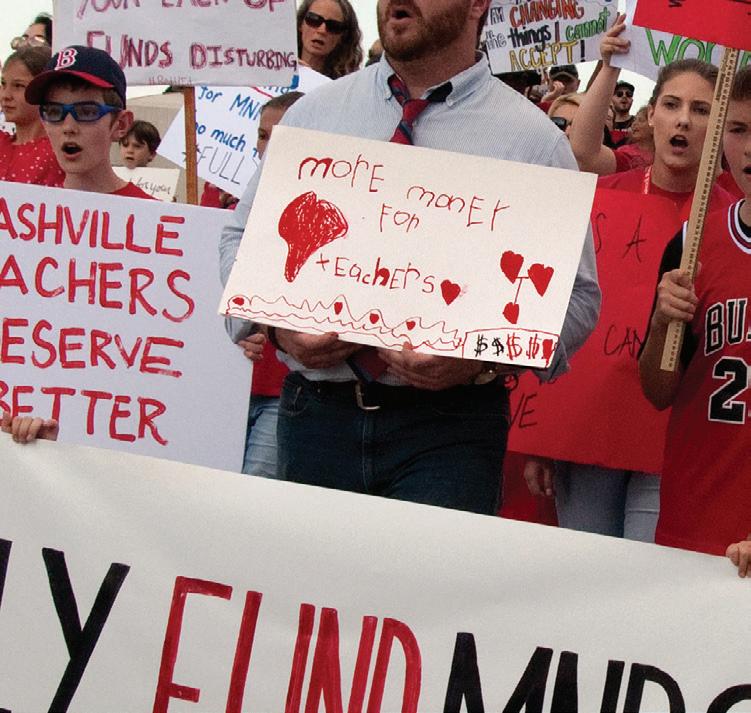

And Rep. Charlie Baum, a Murfreesboro Republican who sits on the House Finance Committee, worried about the proposal’s high cost. He noted that Tennessee’s government faces a $400 million shortfall in its current budget.
“I understand that we’re adding the additional sections to make the bill more enticing, maybe to sweeten the pot,” said Baum, who later voted for the measure. “But it seems like in order to pass a $140 million freedom accounts [voucher] bill, we’re spending an additional $350 million” for public schools.
Baum asked sponsors to consider separate bills to vote on the private school voucher and public school provisions based on their costs and merits. But Rep. Scott Cepicky, a Maury County Republican who is carrying the bill for House Majority Leader William Lamberth, declined.
The voucher proposal, Cepicky said, was the right “vehicle” to address
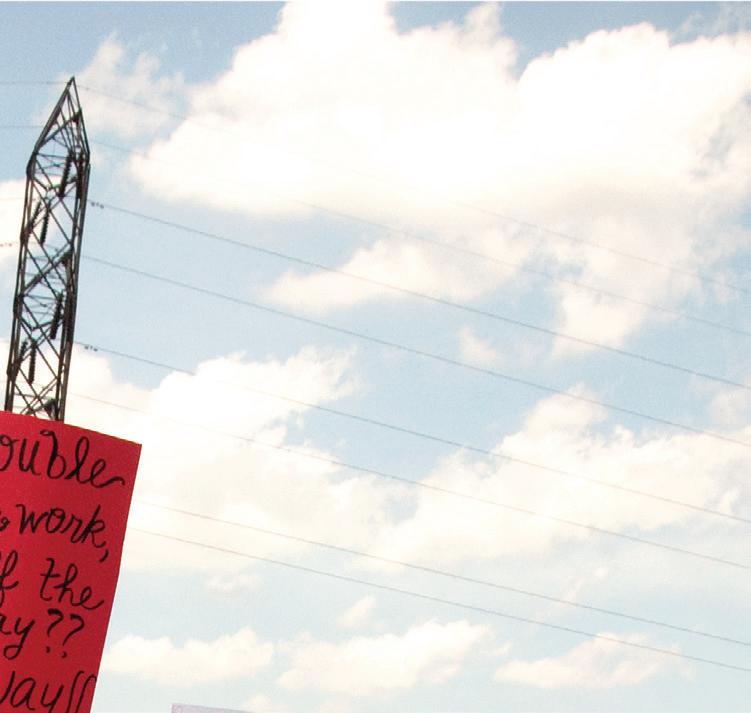

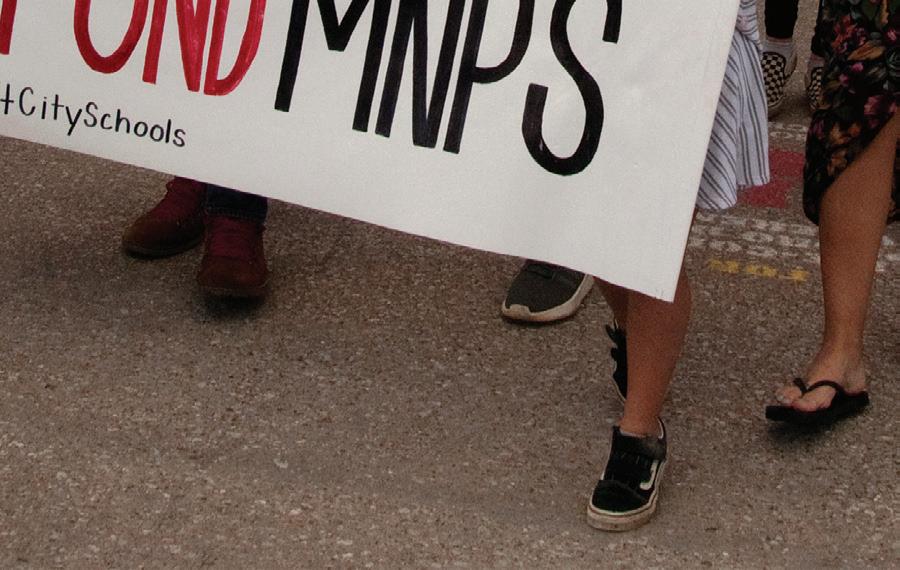




long-standing challenges for public educators.
Rep. Antonio Parkinson balked at that statement though. The Memphis Democrat said lawmakers have the power any time to create legislation to address matters related to public education.
“For some reason, we’ve chosen to create a lemon,” said Parkinson, seizing on the same automotive analogy. “And that vehicle now has all of these great options that are in it, but is tied to four flat tires.”
The House debate waded into the potential for voucher money going to undocumented students or to private schools teaching atheist, Satanic or Muslim curriculum.
Questions also were raised about whether federally required services for students with special needs would lead to new federal regulations on private schools that accept vouchers. There was little discussion, however,
about whether voucher recipients with special needs would receive adequate services from private schools.
Chairman Mark White, a Republican from Memphis, also received complaints from several people who weren’t allowed to testify.
While two people each spoke for and against vouchers, pro-voucher voices included Robby Starbuck, a video director and conservative political activist, and Walter Blanks Jr., a spokesperson for the American Federation for Children advocacy group. White declined to hear testimony from voucher opponents Eric Welch, an elected school board member from Williamson County, and Matt Steinhauer, a Franklin pastor and parent.
In the other chamber, Sen. Raumesh Akbari, a Democrat from Memphis, questioned why the Senate bill doesn’t require voucher schools to be held to the same ac-
countability standards as public schools, including TCAP tests, Tennessee’s third grade retention law and the state’s new A-F designations for schools.
“If the majority of students in that [private] school who are taking these public dollars are performing poorly, will the school face any action based on what’s written in this legislation, where they can no longer accept students who have these vouchers?” Akbari asked.
Senate Education Committee Chairman Jon Lundberg, who drafted the Senate’s version, responded no.
Marta Aldrich is a senior correspondent and covers the statehouse for Chalkbeat Tennessee. Contact her at maldrich@chalkbeat.org. Bureau Chief Tonyaa Weathersbee contributed to this report. Chalkbeat is a nonprofit news site covering educational change in public schools.
“The Contributor” está trabajando con uno de los principales periódicos en español La Noticia para llevar contenido a más lectores en Middle Tennessee. Nuestros vendedores de periódicos han pedido durante mucho tiempo que nuestra publicación incluya contenido que apele al interés de residentes de habla hispana en nuestra comunidad.
“The Contributor” is working with one of the leading Spanish-language newspapers La Noticia to bring content to more readers in Middle Tennessee. Our newspaper vendors have long requested that our publication include content that appeals to the interest of Spanish-speaking residents in our community.

Fallo Plantea
Desafíos para
Iniciativas
Económicas
Inclusivas
En un fallo* impactante reciente, un juez federal en Texas declaró inconstitucionales los programas de asistencia de una agencia de gobierno a negocios de minorías, marcando un importante revés en los esfuerzos continuos para abordar las disparidades raciales en las oportunidades económicas. Estos programas fueron establecidos con la noble intención de fomentar la inclusión y mitigar las desventajas históricas enfrentadas por los empresa-rios minoritarios. Sin embargo, la decisión del tribunal ha arrojado una sombra sobre el futuro de estas iniciativas, dejando a muchos preocupados por las posibles consecuencias.


sación sobre la acción afirmativa requiere un enfoque matizado, teniendo en cuenta la complejidad de las disparidades históricas y sistémicas.
El veredicto del tribunal ha reavivado el debate legal más amplio en torno a la acción afirmativa y los programas de diversidad, que están diseñados para rectificar las desigualdades sistémicas. Los partidarios argumentan que estas iniciativas desempeñan un papel crucial en la creación de una sociedad más equitativa, proporcionando a los grupos subrepresentados herramientas y recursos esenciales para tener éxito en diversas industrias. Por otro lado, los opositores sostienen que dichos programas pueden perpetuar inadvertidamente la discriminación y violar el principio de igual protección bajo la ley.
Los programas de negocios para

minorías en cuestión fueron diseñados para nivelar el campo de juego ofreciendo apoyo específico a las empresas propiedad de minorías. Este apoyo a menudo incluye incentivos financieros, reservas de contratos gubernamentales y acceso a oportunidades de capacitación y networking, con el objetivo final de desmantelar las barreras sistémicas que históricamente han dificultado el éxito de los empresarios del segmento de minorías.
La decisión del tribunal plantea preguntas críticas sobre la constitucionalidad de estas iniciativas bien intencionadas, creando incertidumbre sobre el futuro de los esfuerzos para abordar las disparidades raciales en los negocios. Los críticos argumen-

Conoce tus derechos:
¿Que hacer en caso de una redada?
1. Mantenerse callado
2. Sólo dar nombre y apellido
3. No mentir
4. Nunca acepte/lleve documentos falsos
5. No revelar su situación migratoria
6. No llevar documentación de otro país
7. En caso de ser arrestado, mostrarla Tarjeta Miranda (llámenos si necesita una)
Basados en la Quinta Enmienda de la Constitución, los derechos de guardar silencio y contar con un abogado fueron denominados Derechos Miranda luego de la decisión de la Suprema Corte de Justicia de Estados Unidos en el caso Miranda vs. Arizona, 384 U.S. 436, de 1966.

tan que el fallo socava el progreso realizado en la promoción de la diversidad y la inclusión, potencialmente obstaculizando el avance de las empresas propiedad de minorías en Texas y más allá.
A medida que la batalla legal se desarrolla, las partes interesadas deben considerar enfoques alternativos para fomentar la inclusión sin violar principios legales. Los esfuerzos colaborativos entre entidades gubernamentales, empresas y grupos de defensa pueden conducir a soluciones innovadoras que aborden las causas fundamentales de la desigualdad. Esta situación sirve como recordatorio de que la conver-
El impacto del fallo se extiende más allá del estado de la Estrella Solitaria (Lone Star), influenciando la dirección de programas e iniciativas similares en todo el país. Ya sea que la decisión provoque una reevaluación del marco legal en torno a la acción afirmativa o desencadene una discusión más matizada sobre estrategias alternativas, subraya la necesidad apremiante de encontrar formas efectivas de abordar las disparidades raciales sin comprometer los principios constitucionales. Ante este desafío legal, se vuelve imperativo que los defensores de la inclusividad se unan, trabajando hacia soluciones integrales y legalmente sólidas que puedan resistir el escrutinio. El camino hacia una sociedad más equitativa está, sin duda, lleno de desafíos, pero el compromiso colectivo con la justicia y la equidad sigue siendo una fuerza poderosa que puede allanar el camino hacia un cambio duradero.
Envíenos sus sugerencias por e-mail: news@hispanicpaper.com ó 615-567-3569
*Nota del editor : El Juez Federal de los Estados Unidos para el Distrito Norte de Texas, Mark Pittman, designado por el expresidente Donald Trump, emitió el fallo tras una demanda presentada por varios propietarios de negocios blancos contra la Agencia de Desarrollo de Negocios Minoritarios (MBDA), cuya misión es promover el crecimiento y la competitividad global de las empresas comerciales minoritarias. -Yuri Cunza


King Kong
Release Date: 4-7-1933
Runtime: 1:40
Black and White
King Kong would be 90 years old today, if he were alive, that is. Thank God he’s not. A character’s fi rst appearance in a movie is his birthday. King Kong is older than Godzilla. Th is was a pretty good movie for 1933.

King Kong: Skull Island
Release Date: 3-10-2017
Runtime:1:58
Rated: PG-13
Tagline: “Awaken the King”
Th is is still yet another remake of the 1933 King Kong, but better. King Kong fi ghts more monsters in this one than the original.

Godzilla Release Date: 11-3-1954
Released in Japan
Runtime: 1:36
Now here’s the original Godzilla, which spawned so many sequels it’s crazy. Th is movie started the whole thing. Hopefully the new movies will show minor appearances of Mothra, Rodan and Anguirus the spikey little fellow.

Godzilla: King of the Monsters
Release Date: 5-31-2019
Runtime: 2:12
Rated: PG-13
Tagline: Let them Fight!
After 50+ years, they fi nally have all the other monsters bow down before Godzilla, acknowledging him as the King of the monsters. Finally!! In the credits, Godzilla, Mothra, Ghidorah and Rodan are credited as themselves. If you don’t believe it then check out the credits at the end of this movie.


King Kong Vs. Godzilla
Release Date: 8-11-1962
Runtime: 1:37
Th is is the worst King Kong appearance, but you should watch it to prepare for the new Gozilla vs. King Kong movies.
Now, for the new versions.

Godzilla vs. Kong
Release Date: 3-31-2021
Runtime: 1:53
Rated: PG-13
It turns out that Godzilla and King Kong are guardians or wardens of the monsterverse. And they fi ght a revived Godzilla.
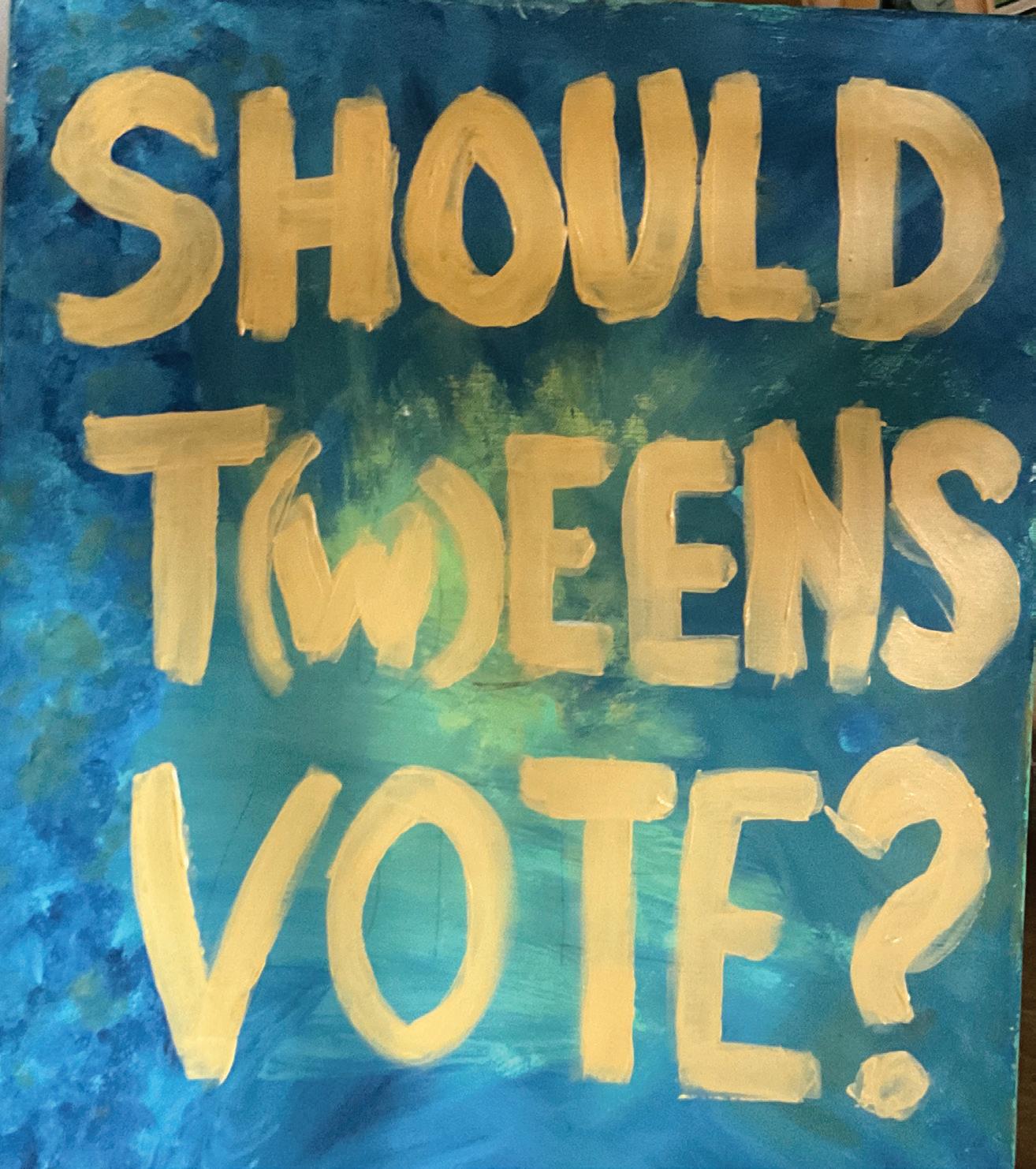
The
Are we going (somewhere) in a handbasket?
I brought my latest sign to the street. It landed like a lead balloon. Except for with the kids! They were very excited. I could see them gesticulating behind glass, which the parents never opened their car windows because, well -they didn’t agree that their Tweens and Teens should be able to vote.
Perhaps they thought I would be a bad influence! I really did think I was just bringing up the question, but apparently it caused a fire storm in a few different cars.
But here’s the thing: kids these days are faced with AK-47’s suddenly appearing in their schools, global warming, and traffic congestion beyond belief. They are also experiencing the hardships of their parents who might have to live far from town in order to be able to afford to be at work in Nashville. And they are being driven all over town just to get to school. The parents are afraid to let them ride the bus. Only very poor parents allow their kids to ride the bus. That doesn’t mean the buses aren’t filled with school kids at particular hours of the day. They are. It just means that way too many parents are driving all over town, causing even more congestion.
The Catholic Church states that children reach the age of reason at seven years old. They take their first communion at 12 years old. Why wouldn’t we do our kids the same favor, treating
them as concerned about their future? Of voting on issues that directly concern them, such as school funding? School choice? Whether or not to pay our teachers properly so that all schools can be high-quality here.
My godson, age 11, had this to say:
“All AK-47 and automatic weapons and handguns should be banned. No citizens should be allowed to own one. Only the military should have AK-47’s, and then only in dire situations. People who need to hunt can use hunting rifles. They need to register for each gun they need to get.”
Who could argue with the logic of this? Who could argue that he is not able to see the situation clearly, and make choices?
I know that many issues that concerned me when I was a teen were not decided by me. I lived with the consequences starting at age 18. I was one of the few who actually voted. By then, apathy had set in with most kids, because well, we hadn’t really been allowed to put our voice in before that, and so the sudden demarcation at age 18 seemed pretty illogical. Most people felt they were powerless. I think they learned this in high school. We were carried around in a handbasket for quite a while. In fact, about six years if you count middle school.
What do you think? Weigh in by emailing editorial@thecontributor.org.
Have you ever looked in a mirror and failed to recognize
The reflection staring back at you from the other side?
It can be disconcerting
Trying to differentiate between the reflection you remember from the days of your youth and the one you now see starring back at you now
The youthful glow
You once took for granted
Has now been replaced with wrinkles and lines
How do you reconcile how you feel on the inside with what you see on the outside
You find yourself wondering
What in the world is going on, Feeling a bit anxious and confused
As if you’re traveling through time
Flooded with memories both old and new
Some bring happiness making me grin like a Cheshire Cat
Others make you sad,
And you shed bittersweet tears filled with regret
For all that has been left behind and what might have been
Words left unsaid
NEVER spoken to those we love the most
You thought you had plenty of time
To express the things
You was feeling inside
Deeds left undone
Loved ones left to question
How you REALLY felt about them
When comparing ancient times and modern times, I did not want to do the obvious comparisons, such as transportation, climate controlled homes, and all the other machines and technology that we have today that our ancestors did not have. But instead, I wanted to discuss how we study and worship God with our neighbors, and compare how the ancient ones worshiped and studied with their congregation.
First, archaeologists date the stones of the Earth back, 3.3 million years ago. That’s a long time past, and notable to say God the creator created first his Word. I was born in 1964, and have seen many changes in human kind and the Earth’s atmosphere. I want to write about the ancient scriptures and listen to what God and Christ have to say about the times. Ecclesiastes 3:5 says, “That which hath been is now, and that which is to be already hath been, and God requireth that which is past.” Another verse from Ecclesiastes 1:9, “The things that have been, it is that which shall be, and which is done is that which shall be done, and there is nothing new under the sun.” I’m not a Biblical
All the What if’s and If only’s
Running through your mind so rampantly
Speaking of those memories
You hold SO dear
Why are some like an old photograph
Faded with time
While others you would like to forget
Remain crystal clear in your mind
Though they happened years ago
It seems like only yesterday
Still others are completely gone as though they never happened at all!
All these things make a life unique
If ANY part was missing, you feel incomplete
You find your physical senses are heightened too
Special places that have shaped who you are now
Sites you thought would ALWAYS be around to see and to share with family and friends
As well as those new to the neighborhood
Now they’re gone with only a monument or plaque to show where they once stood
Smells fill the air that remind me
Of simpler times
Like days on the farm the taste of Grandma’s cooking
Churning butter and canning fruits and vegetables in jars
Making lye soap in flower shaped molds
ALL this was done at a time and place where you felt safe
The sound of music reminds me of my mother who could sing, dance a jig, and play most any tune
On an old guitar with well-worn strings
There are the times spent with my Pop who taught me SO many valuable things
like how to milk a cow and count change from the pool room where he worked so hard
He even let me drive his old John Deere around the yard(that last one didn’t end so well)
I flipped it over and tore a hole in the fence, cows then stood where they ought not have been
And even though I wasn’t hurt at all
Not even a scratch
I must admit I was scared to death
when I was trapped in the small space between the seat and the ground
Needless to say, I was NEVER allowed to drive that old John Deere AGAIN!
That reminds me of my dad
I didn’t have enough time with him
He died when I was just 15
He too tried to teach me to drive
He was SO full of pride as I sat on his lap
That is until his shiny red truck almost landed in the pond! With that the driving lesson came to an end!
Ah the pond where my dad first taught me to fish and bait my own hook with a real live worm, Useful skills for ANY girl!
He even taught me how to shoot his gun!
I’m kinda glad he never got around to hunting
I’m not sure I could handle killing a little bunny or a deer I didn’t have a problem eating them though, especially when my Aunt Mary prepared the meal
I can still see her cooking up a storm on the stove
Yes ALL these things and SO much more make up a clear reflection of
A life well-lived with those we love!
scholar, but Second Timothy 2:5 tells us to shew thyself approved unto God, a workman that needeth not to be ashamed, rightly dividing the word of truth.” So, I wonder what the life of an ancient Jewish person was like. I read that ancient Jewish boys learned to memorize the Torah, and a primary education would have taught him in detail the Mosaic history and law.
In this time we live in today, people do send their children to private schools. I can’t write on that because I went to public school. Our lessons were the basics: reading, writing, math, American history. We did bless our meals, gave our allegiance to the flag, and were punished with a paddle for bad behaviors. I’m sure the ancient Jewish children were taught mathematics, numbers and how to count livestock, money or any other material that was important, as we do today. Life expectancy for a Jewish male was 72. I was surprised at that, compared to today’s life expectancy for a male, which is about the same at 77. Jewish girls of the community was not given an education like the boys, which brings me to the invention of the computer.
I learned to operate a computer by my then
9-year-old daughter. I get it, the man is supposed to provide for his family, but that’s another topic. I'm glad to see women doing what they have to do, because in my opinion women make the world a better place when they, too, are productive. The home computer was invented in my lifetime, information at the click of a button, no more library card catalog. The only problem is that a person has to do a lot of fact checking. Ancient people used astrology like the Magi traveling to the birthplace of Christ. In Matthew 2:1-2 after Jesus was born in Bethlehem in Judea, Magi came to Jerusalem, and asked, “where is the one who's been born King of the Jews? We saw the star when it rose and have come to worship him.”
I found this article by Diane Rudd that said the Magi that appeared during the birth of Christ are most likely members of a sect of Magi which follow the same order of prophecies as the prophet Daniel. And most of the Magi were astrologers When comparing the two, computers are programs, as far as I know, and cannot predict the future. The computer images and photos will leave an impression
upon your memory. Do the verses Exodus 20:2, Daniel 12:4 and Matthew 24:14 represent the computer?
And finally I’d like to compare the services and the worship of God and his word. An article by Louis Tverberg says the synagogues did not have a single leader who preached every week like Rabbi or Pastors do today. Instead, one adult member of the congregation would be invited to read the Torah portion, he would then choose a prophetic passage that fit the Torah reading and would give a brief meditation on how both passages relate to each other. The prophetic reading was called the Haftarah, which means completion. People who attend church today know the tradition of the service, and I’ll just say God’s word is the important part of it all. The Church today provides a Bible Study for adults and some churches have other programs that a believer can take advantage of, also Bible school for the children and other events.
In conclusion, I’ll just state what King Solomon stated. There is nothing new under the sun, God’s word will stand the test of time. I will not try to test it, but show myself approved.
Selected by Charles Williams
Charles Walter Stansby Williams (1886–1945), the editor of the following selections, is today probably the third most famous of the famous Inklings literary group of Oxford, England, which existed in the middle of the 20th century, and which included among its ranks the better-known and longer-lived Oxford Dons J.R.R. Tolkien and C. S. Lewis. First published in 1941, this series of profound quotations, encompassing all walks of life, follows the sequence of the themes and Bible readings anciently appointed for contemplation throughout the church's year. It is hoped that the readings reproduced here will prove beneficial for any who read them, whatever their place in life's journey. — Matthew Carver
5TH MONDAY IN LENT
THAT God the Lord, the Lord of life could die, is a strange contemplation; . . . but that God would die, is an exaltation of that; but, even of that also, it is a super-exaltation, that God should die, must die; . . . God is the God of revenges; he would not pass over the sin of man unrevenged, unpunished; But then the God of revenges works freely; he punished, he spares whom he will; and would he not spare himself; He would not. . . Love is as strong as death; stronger; it drew in death, that naturally was not welcome.
Donne: Sermons
HE alone . . . for us to thee both Victor and Victim and therefore Victor because of Victim; for us the thee Priest and Sacrifice; making us to thee of servants sons, by being born of thee, and serving us.
St Augustine: Confessions
5TH THURSDAY IN LENT
WHEN all is done, with this cross thus laid out for me, and taken up by me, I must follow Christ; Christ to his end; his end is his cross; that is, I must bring my cross to his; lay down my cross at the foot of his; confess that there is no dignity, no merit in mine, but as it receives an impression, a sanctification from his. If I could die a thousand times for Christ, this were nothing, if Christ had not died for me before.
Donne: Sermons
THOU dost nowhere depart from us, and we hardly return unto thee.
St Augustine: Confessions
GOD always goes before our contemplation; we can never here overtake him who is our highest beatitude.
Dante: Convivio
GOD is the essence as well as the object of religion.
Coleridge: Anima Poetae
THE same act, for good or evil, is judged differently, accordingly as it proceeds from a different source. The Father delivered up Christ, and Christ surrendered Himself, from charity, and consequently we give praise to both: but Judas betrayed Christ from greed, the Jews from envy and Pilate from worldly fear, for he stood in fear of Caesar; and these accordingly are held guilty.
Aquinas: Summa Theologica
HE gave power unto the sharp thorns to enter and most cruelly wound His divine and trembling head; He empowered the bonds and bitter cords to bind Him fast unto the pillar and ties His hands together; . . . He gave unto the hard nails power to pierce and enter His tender feet and the hands wherewith He had given light unto the blind and hearing unto the deaf; . . . He empowered the lofty cross that it should bear Him on high, . . . He caused the vinegar and hyssop to make bitter his mouth; He caused (oh, marvellous to hear!) the lance to enter and pierce through His divine side and heart.
Angela of Foligno: The Book of Divine Consolation
AS of His own will His bodily nature kept its vigour to the end, so likewise, when He willed, he suddenly succumbed to the injury inflicted.
Aquinas: Summa Theologica
FIFTH SUNDAY IN LENT
IN Christ ye are under grace. Comprehending Him, ye are comprehended in His death; with His human body ye are made dead. All human possibilities, including the possibility of religion, have been offered and surrendered to God on Golgotha . . . Golgotha is the end of law and the frontier of religion . . . through the slain body of Christ, we are what we are not.
Barth: Epistle to the Romans
THE beginning of our Lord's entrance into the terrible jaws of this second death may be justly dated from those affecting words, "My soul is exceeding sorrowful even unto death; tarry ye here with me and watch." See here the Lord of life reduced to such distress as to beg the prayers, watching and assistance of His poor disciples! A plain proof that it was not the sufferings of this world, but a state of dreadful dereliction that was coming upon Him. O holy Redeemer, that I knew how to describe the anguishing terrors of thy soul, when thou wast entering into eternal death, that no other son of man might fall into it!
William Law: An Appeal
AS He was uplifted above others in gifts of graces, so was He lowered beneath others by the ignominy of His sufferings.
Aquinas: Summa Theologica
THE will maketh the beginning, the middle, and the end of everything; it is the only workman in nature, and everything is its work. It has all power, its works cannot be hindered, it carries all before it, it creates as it goes and all things are possible to it. It enters whenever it wills and finds everything that it seeks, for its seeking is its finding. The will overrules all nature, because nature is its offspring and born of it; for all the properties of nature, whether the be good or evil, in darkness or in light, in love or in hatred, in wrath or in meekness, in pride or humility, in trouble or birth of the will; as that liveth so, they live, and as that changeth, so they change.
William Law: Divine Knowledge
I ASKED Him to let me suffer for my friends and for Him both in body and soul. But I had envisaged noble and pure suffering which, as I now see, would only have been another form of joy. I had never dreamed of this infernal suffering that He has sent me and has consisted in His seeming withdrawal from me and leaving me defenseless in the midst of my cruellest enemies.
Léon Bloy: Letters to his Fiancée.
6TH THURSDAY IN LENT
HIS hour was not yet come. This is, because He was not so pleased; for our Lord was not born subject to fate. Thou must not believe this even of thyself, much less of Him by Whom thou wert made. And if thine hour is in His will, is not His hour in His own will? His hour then here does not mean the time that he was obliged to die, but the time that He deigned to be put to death.
St. Augustine, quoted by St. Thomas Aquinas: Catena Aurea.
THE originator of this cup is also one with him who drank it. St. Augustine: Lectures on St. John.
6TH FRIDAY IN LENT
WHAT will move you? Will pity? Here is distress never the like. Will duty? Here is a person never the like. Will fear? Here is wrath never the like. Will remorse? Here are sins never the like. Will kindness? Here is love never the like. Will bounty? Here are benefits never the like. Will all these? Here they be all, all in the highest degree.
Lancelot Andrewes: Sermon on Good Friday, 1604.
WHEN the Messiah . . . stands alone before the high-priest, deserted even by the chosen disciples . . . he is the sole representative at that moment of God's holy people; he bears in his own person the whole burden of Israel's appointed destiny. Doctrine in the Church of England, Report of the Commission.
Donne: Sermons
WHO but Himself could trouble Him? Christ was troubled, because it pleased Him to be troubled; He hungered because it pleased Him to hunger. It was in His own power to be affected in this or that
Sponsored by Matthew Carver, publisher
way, or not. The Word took up soul and flesh, and whole man, and fitted it to Himself in unity of person. And thus according to the nod and will of that higher nature in Him, in which the sovereign power resides, He becomes weak and troubled.
St Augustine, quoted by St. Thomas Aquinas: Catena Aurea.
NO manner of violence offered him in body, no man touching him or being near him; in a cold night, for they were fain to have a fire within doors, lying abroad in the air and upon the cold earth, to be all of a sweat, and that sweat to be blood; and not as they call it diaphoreticus, "a thin faint sweat," but grumosus, "of great drops"; and those so many, so plenteous, as they went through his apparel and all . . . never the like sweat certainly, and therefore never the like sorrow.
Lancelot Andrewes: Sermon on Good Friday, 1604.
. . . TO live thus, to cram to-day with eternity and not with the next day, the Christian has learnt and continues to learn (for the Christian is always learning) from the Pattern. How did He manage to live without anxiety for the next day—he who from the first instant of His public life when He stepped forward as a teacher knew how His life would end, that the next day was His crucifixion, knew this while the people exultantly hailed Him as King (ah, bitter knowledge to have at precisely that moment!), knew when they were crying, "Hosanna!", at His entry into Jerusalem that they would cry, "Crucify Him!", and that it was to this end He made His entry; He who bore every day the prodigious weight of this superhuman knowledge—how did He manage to live without anxiety for the next day?
Kierkegaard: Christian Discourses.
IF a poet or an artist puts himself into his productions he is criticized. But that is exactly what God does, he does so in Christ. And precisely that is Christianity. The creation was really only completed when God included himself in it. Before the coming of Christ God was certainly in the creation but as an invisible sign, like the watermark in paper. But the creation was completed by the incarnation because God thereby included himself in it.
Søren Kierkegaard: Journals.
[LOVE said] What! Most of all, did I not make a loveday between God and mankind, and chose a maid to be compere [companion], to put the quarrel at end?
Thomas Usk: Testament of Love.
THE progress of these terrors are plainly shown us in our Lord's agony in the garden, when the reality of this eternal death so broke in upon Him, so awakened and stirred itself in Him, as to force great drops of blood to sweat from His body . . . His agony was His entrance into the last eternal terrors of the lost soul, into the real horrors of that dreadful eternal death which man unredeemed must have died into when he left this world. We are therefore not to consider our Lord's death upon the cross as only the death of that mortal body which was nailed to it, but we are to look upon Him with wounded hearts, as fixed and fastened in the state of that two-fold death, which was due to the fallen nature, out of which He could not come til He could say, "It is finished; Father into thy hands I commend my spirit."
William Law: An Appeal.
HE said to Judas, when he betrayed him: "Friend, wherefore art thou come?" Just as if he had said: "Thou hatest me, and art mine enemy, yet I love thee and am thy friend." . . . As though God in human nature were saying: "I am pure, simple Goodness, and therefore I cannot will or desire or rejoice in, or do or give anything but goodness. If I am to reward thee for thy evil and wickedness I must do it with goodness, for I am and have nothing else."
Theologica Germanica.

ACROSS
1. College cadet program
5. Comedian Schumer
8. Not square
11. October birthstone
12. Dueling weapon
13. FlambÈ
15. Capital of Azerbaijan
16. Rugged rock
17. Actress Vergara
18. *What many chicks are doing in spring
20. "Me and Bobby McGee" singer-songwriter
21. *What the weather does in spring across the U.S. 22. Make a seam
23. Old name for 5-iron in golf
1. What highwaymen do
2. Moonfish
3. Bangladeshi currency
4. Type of purse
5. *Simon & Garfunkel: "____, come she will"
6. Wealth
7. Safecracker
8. High quality sound reproduction, for short
9. *Purple flower that starts blooming in spring
10. Fairytale insomnia cause
12. Like repeating tunnel sound
13. Off kilter
14. *"Spring ____, fall back"
19. Spring mattress filler
22. Acronym in a bottle
23. Ceremonial staff bearer
24. Skylit lobbies
25. "Designing Women" star Jean ____
26. *Become soft, as in ground
27. Radices, sing.
28. "Way 2 Sexy" rapper
29. "Battle of the ____" movie
32. Swimming competition, e.g.
33. Not amateur
36. *The ____: "Little darlin', it's been a long, cold, lonely winter"
38. Highly skilled
40. *Official start of spring
41. Make bigger
44. Vanish without this?
46. Elevates
48. Dry plateau in South Africa
49. Oak nut
50. Same as tsar
51. "The Dock of the Bay" singer
52. Joe Biden, once
53. Solemn promise
54. Pinta and Santa Maria companion
55. Vegas bandit's body part
58. *It gets longer
Play the Game and Play the Game well, And always remember...
“Keep Hanging On for The Ride” People who meet you will be able to tell, Whether or not you’ve got something to hide?
Can anyone make a positive difference?
Is it worth all the Effort? Is it worth the Expense?
The loss and the cost of the Hard Lessons Learned, And the high price we pay for Experience?
Was it fun while it lasted? Were you glad you got past it? Was it time you invested or carelessly spent?
Don’t waste it wondering, where the hell the time went?
You can’t go back and do it again. But that’s not how the story ends. So never give up until then, my friend.
“Keep Hanging On for The Ride”
“Keep Hanging On for The Ride”
Instead of Slow Suicide.
For Better or Worse is for you to decide.
“Keep Hanging On for The Ride”
“Keep Hanging On for The Ride”
Change can be strange, but again and again, It’s bound to keep, right-on, happening. Making a living the best that you can.
Taking on every challenge. With so much to lose and so much at stake. Questioning every move that you make?
Do you choose to have too much upon your plate?
Paying your Dues and Accepting your Fate. The difficult times that you have to go through, And the times that you have to wait. Don’t waste another minute in it wondering, Whether or not it’s too late?
“Keep Hanging On for The Ride”
Instead of Slow Suicide. For Better or Worse is for you to decide.
“Keep Hanging On for The Ride”
“Keep Hanging On for The Ride”
Is it better to fail? Instead of prevail?
There’s nothing so bad, You can't rise above it. It's a simple fact, You've got to Love it. It’s not a dress rehearsal, Remember this, For better or worse, It is what it is.
Live Life like, It’s your only one. Don’t forget, To have yourself, A little fun.
We’re all riding off, Into the setting sun.
So, Live Life like, It’s your only one.
You can’t see the forest, Through the trees, When you’re singing, Oh, poor, poor pitiful me. They can’t take away, What you refuse to give. So, make today the day, You choose to live.
Live Life like, It’s your only one. So much to do. So much to get done. Don’t waste it, Waiting for, That day to come.
Live Life like, It’s your only one.
55.
56.

By choosing to hide, What you keep deep inside. Like holding a tiger by the tail, When you’re ready and willing, To set your sails, and say hey, “You made yourself Available” And without a doubt, how hard, you tried?
“Keep Hanging On for The Ride”
“Keep Hanging On for The Ride”
Instead of Slow Suicide. For Better or Worse is for you to decide.
“Keep Hanging On for The Ride”
“Keep Hanging On for The Ride”
Tomorrow’s not promised. The past is past. Make the most, Of every moment, They go by fast. You’re wishing for, Your happiness, To come along, But missing it, Looking at, It all wrong.
Live Life like, It’s your only one. It’s here today, And tomorrow gone. The only thing that matters, When it’s said and done, Is Live Life like, It’s your only one.
So it seems we disagree about the future, Aries. You keep telling me tomorrow will be just like today. I say, “but look at yesterday! That was different! Maybe tomorrow will be even more different!” You’re convinced that nothing can change and I insist that it always does. The funny thing is, Aries, that neither of us know. We’ve got fears and hopes and stories and guesses, but nobody really knows what’s coming next. I think the best bet, if the past has anything to offer, is that we’ll do better if we go together.
Two roads diverge in a yellow wood, Taurus. But, wait, does that pile of leaves look familiar to you? And isn’t this your Clif bar wrapper from this morning? I’m afraid we’ve been here before. We must be walking in circles! Don’t worry, Taurus, I know just how to get us out of this. Sure, some choices are bound to lead back to themselves and then we have to keep trying again until we get it right. Whichever way we went last time, Taurus, we’ll just go the other way this time. So which way was it? You remember, right? (I feel like we’ve been taking a lot of lefts lately. Maybe we should keep better notes.)
I get weirded out by those little chocolate eggs that are filled with white and yellow candy egg-goo. I much prefer a good hollow chocolate bunny. You know what you’re getting with a bunny. Nobody’s filling those with lifelike bunny-innard confections. It’s just a layer of chocolate and then an expanse of invisible and probably-breathable air. It’s the stuff of possibilities. You might find you need a little extra space between your long ears this week, Gemini. I’m not surprised. Everything’s been so packed with goo. Get still and take a breath. Wrap yourself in foil if it helps.
CANCER
I guess it started when my upstairs neighbor bought a drum kit. Yeah, that was definitely it. Not that I don’t like music, Cancer, it was just that the rhythmic pounding through the ceiling gave me the constant feeling that the sky was caving in. So I started going for walks. Long walks. Pretty soon I found I was only returning home to feed the fish and grab a can of peaches or an umbrella. I’m not even sure when the drumming stopped. But I’m more tuned-in to the never-falling sky than ever. Did the neighbor move out? I hope it was just a pivot to something softer like crocheting or making meringue. So much of life is what you focus on.
I can never remember what day we’re supposed to wear green so I just make sure to wear a little bit all the time. Like, yesterday I wore my Mountain Dew T-shirt. Today I’m wearing my fuzzy green socks. Tomorrow I’ll probably wear my Mountain Dew bandana. (I may have more Mountain Dew merch than most people.) It’s the only way to be absolutely sure that I’m wearing green at that crucial moment so I never get pinched. You’ve been working hard to do everything just right too, Leo. But I think the more you prepare for the worst outcomes, the scarier those outcomes start to sound. Maybe let it slide just a little. Getting pinched isn’t as bad as I thought it would be.
A couple of times a year, I wake up desperate for pancakes. You’d think I’d learn the recipe, Virgo, but I have to google it every time. I just search for one that only needs the ingredients I already have in the kitchen. Sometimes I still have to make substitutions. So this morning I had a delicious shortstack made from cornmeal, cashew milk, pringles-crumbs, and vanilla pudding. They barely even needed syrup (which was great, because I only have ketchup). I’m wondering, Virgo, if you and I could benefit from a little more planning. What’s something that you don’t need right now, but that you’ll probably need later?
They’re making a musical out of your life, Libra. They figured since the original was so successful they could remake it with younger actors, add a couple of catchy songs, and flesh-out some of the side characters we didn’t pay attention to the first time around. Anyway, I assume it will be great. Mostly because I’ve always wondered what you sing about when you’re alone. What’s the one thing you want that’s driving this whole plot forward? If you don’t like the sound of that song, this is a good time to make some changes.
When it’s all done and this life is over, Scorpio, I don’t know for sure if there will be a big reward, or a big emptiness, or if I’ll restart as something new. But whatever it is, I hope that as the credits roll they play a blooper reel. I’d love to see all the times I got my lines wrong or came in too late or too early. More than that I want a collection of all the times you and I cracked-up trying to get the words out, laughing till we were afraid we couldn’t breathe and the tears came down our necks. It reminds me, Scorpio, that I don’t know what’s next, but I know what’s now, and I know that what I like the most isn’t getting it right, it’s being together trying our best. Let’s do one more take.

My great-great-grandfather Mysterio traded two trained plowing-mules for a diamond ring and I guess that’s how this all got started. These days the diamonds are all synthetic. Come to think of it, so are the mules. But we still make those trades. How many days of labor for a token of affection or a promise to stay? It’s a weird system, Sagittarius. What our great-great-grandfathers might not have known is that even if we have to work to live, we don’t have to trade it in for love. Synthetic or mined, there’s a part of you that can’t be bought or sold. It’s always yours to keep or give away.
Nobody stays dead in comic books or soap operas. Heroes who tragically fall just end up getting unfrozen from the ice or turn out to have an identical psychic-twin. Villains who were justly vanquished get cloned or reincarnated. And the cycle goes on. Good beats evil and then evil bounces back. Redemption stories repeat and remix. And we come back to see it happen again, Capricorn, because somewhere we know that defeats aren’t final and victories don’t last. If it looks like it’s over, won or lost, Capricorn, there’s another scene on another page. Keep going.
I just got my weekly screen-time report and I’m up 34 percent. It’s pretty disappointing. I’ve been trying to stay off social media and limiting my streaming. If you want to know the truth, Aquarius, my calculator-app use has gotten a little out of control. I just can’t stop adding up the things in my life that I’m grateful for. I started with my shoes. That was 1. Then I realized I was grateful for my bike. That’s 2. Then I added my 3 favorite books to the list. That’s 5. And it just kept going. You can understand why I needed the calculator. You can try this out too, Aquarius. Everytime you think of something you're grateful for, just add it in. I’m even grateful for this screentime report. That’s 8,341!
My shadow surprised me again today. It’s so much larger than I am this time of day. So flat and menacing, bouncing down the road toward my bus stop. I raise a cup to my mouth and my shadow brandishes a club. I wave at the mailman driving by and my shadow shakes an angry fist. There’s a darkness on the ground beside you too, Pisces. It does what you do but it doesn’t mean what you meant. Don’t ignore it. Watch for the consequences of your simplest motions. It’s not what’s in your heart, I know, but it still shows and needs an answer.





















I was invited to a recent media preview for Dune: Part Two. We watched the film in an IMAX theater at the Regal Opry Mills. That’s my home court commercial theater ever since I moved to Nashville’s east side in 2012. Reclining back in my chair with a cold bottle of water — it’s a three hour film set in a desert — I experienced a feeling I had as a child when I saw Star Wars (Episode IV) in a movie theater in Detroit in 1977. I had a hard time articulating the feeling, but the critics at Film Threat spoke to the same thing in the review on their YouTube channel. Dune: Part Two is the first science fiction film since the original Star Wars to bring the space opera to a definitive new level of visionary artistry and technical excellence. Science fiction movies weren’t the same after Star Wars and new films are all going held to a new standard of imagination and expertise in the vast shadow of this new Dune installment. I had to seek out some other reviews to be able to put all of that into words, because in the moment, in the spice strewn sands of Arrakis, wrenched in the throes of monarchy and prophecy, I was mostly just overwhelmed and thinking, “This is the Star Wars feeling.”
Dune: Part Two will crush everything in the technical awards categories throughout this year’s upcoming awards season. From VFX to sound and probably also score, nothing is going to best this film in the next 10 months. The hallucinatory water of life sequences were a disappointment here, but Paul’s (Timothée Chalamet) first ride on a sandworm is going to go down as one of the greatest action sequences in all of science fiction cinema. The greatest movie magic accomplishment is part of that “Star Wars feeling”: Dune: Part Two’s designs and costumes and all the various renderings of these vehicles, spaces and places feel both believably otherworldly and actually real. Just as Star Wars looked totally new and completely convincing, Dune: Part Two gives us visionary frames that feel fully inhabited and lived-in like no movie since George Lucas took us long ago and far away.
The Star Wars and Dune comparisons are well-deserved and important
to note. But Star Wars is a movie about a hero saving a princess. The Dune saga is an epic that’s closer to Shakespeare than the Brothers Grimm. Dune is a movie about economics, politics, geography, monarchy, religion, revolution and family. For all of these films’ technical accomplishments, both of Dune’s chapters boast the best script in all of the attempts to bring Frank Herbert’s book to screens big and small. And the adaptation is brought to life by a great ensemble cast and multiple stand-out performances. Rebecca Ferguson’s Lady Jessica Atreides is the first great performance by an actress in 2024, and Chalamet’s transformation from a pubescent prince into a warrior messiah demonstrates a range and gravitas that puts him in the best-actor-of-his-generation conversation.
Austin Butler’s heel turn from Elvis to the murderous Feyd-Rautha might make him the year’s best bad guy, and Florence Pugh is measured and luminous as Princess Irulan, daughter to the Emperor Shaddam Corrino IV — an icy performance from Christopher Walken.
Zendaya’s Chani is the only character that doesn’t ring true. It’s partly due to Zendaya’s limited range and clichéd choices. Writer-Director Denis Villeneuve and writer Jon Spaihts script is probably the bigger problem. They need Chani to follow the storyline of the novel, but they also want her to embody the skepticism that will challenge Paul’s rise to power in the next film, Dune Messiah. The result is a passive aggressive confusion of actions all accompanied by the same emotionless scowl from the actress.
That mute scowl gets the last shot in the film, but Villeneuve mostly let’s Chani and Dune’s love story fade into the background where they belong. We’re becoming a god here.
Dune: Part Two is playing now in theaters
Joe Nolan is a critic, columnist and performing singer/songwriter based in East Nashville. Find out more about his projects at www.joenolan.com.

